The Ultimate Easy Gluten-Free Rosemary Focaccia Bread (Vegan & Dairy-Free!)
Crispy on the outside, unbelievably fluffy on the inside, this exquisite gluten-free focaccia bread is surprisingly easy to make and utterly delicious. Infused with aromatic rosemary, this Italian-inspired focaccia is the quintessential table bread, perfect for dipping into a flavorful carrot turmeric soup or a rich creamy pumpkin soup. Beyond soups, it shines as a delightful appetizer, served alongside our renowned easy creamy hummus, or simply enjoyed with a generous drizzle of premium extra virgin olive oil. This recipe proudly caters to various dietary needs, being completely gluten-free, dairy-free, and vegan, making it a joy for everyone at your table.
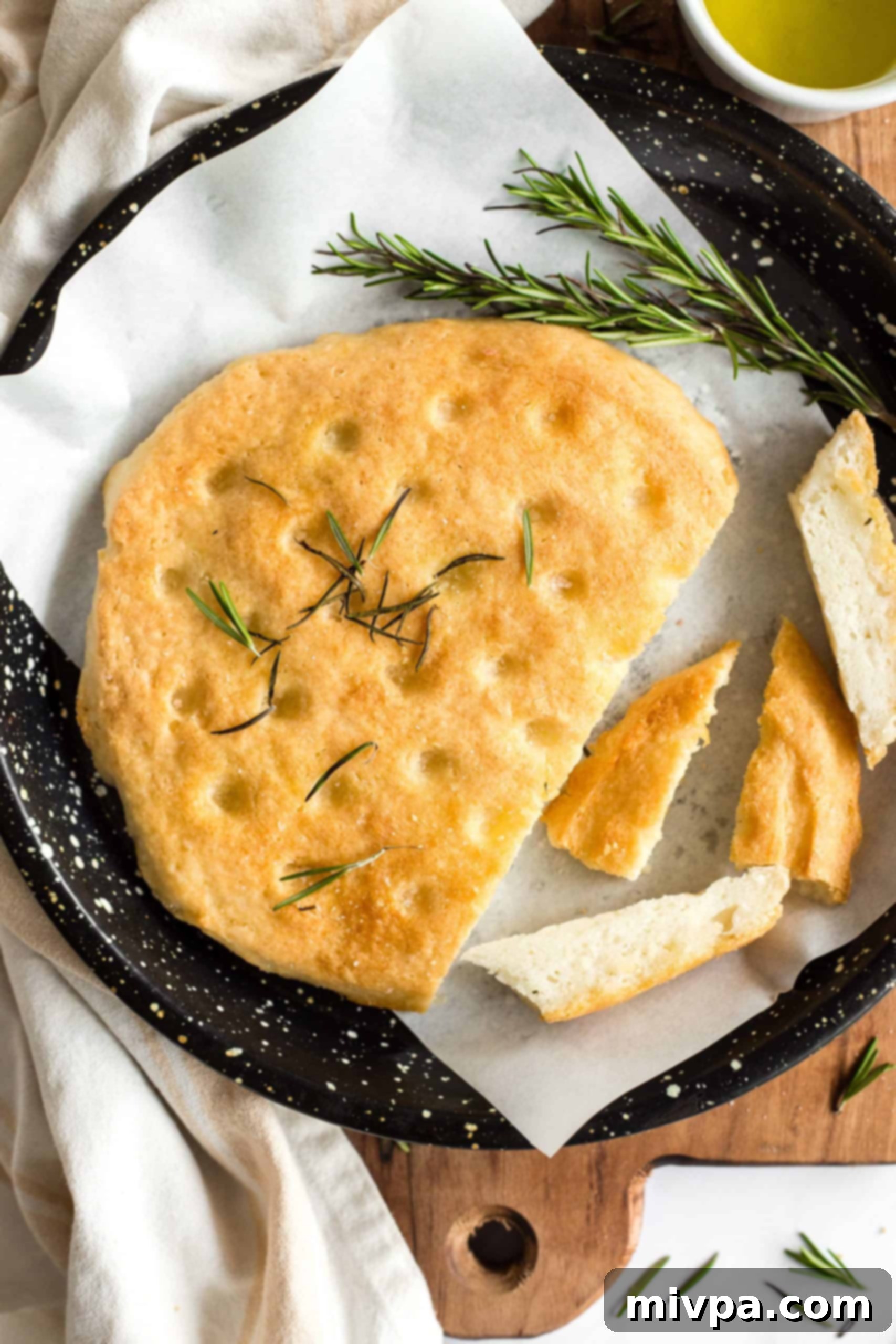
[feast_advanced_jump_to]
My Journey: Gluten-Free Bread Baking Adventures
Embarking on the rewarding journey of bread baking once again has been a true adventure, particularly in the realm of gluten-free creations. The challenge of achieving the perfect texture and flavor without traditional wheat flour is one I’ve eagerly embraced. My kitchen has become a testing ground for countless experiments, resulting in some incredibly successful savory delights. Among my personal favorites are this exceptionally gorgeous gluten-free no-knead bread, which proves that delicious bread doesn’t always require extensive effort. I’ve also perfected an easy gluten-free no-yeast naan bread, a quick and versatile flatbread, and an amazing gluten-free pizza crust that truly holds its own.
My exploration hasn’t stopped there. I’ve delved into yeast-based gluten-free bread recipes, pushing the boundaries of what’s possible. This includes the crazy popular soft and fluffy buckwheat bread, a wonderfully tender gluten-free white bread, wholesome brown rice bread, nutrient-rich quinoa bread, and the delightfully delicate sorghum bread.
For quite some time, one particular bread lingered at the top of my “to-bake” list: a perfectly textured gluten-free focaccia. The vision of a dimpled, olive oil-infused crust with an airy interior was a persistent culinary dream. Last week, I finally dedicated myself to testing this easy focaccia recipe, and the results were beyond my expectations. We absolutely adored its authentic taste and texture, confirming that a truly exceptional gluten-free focaccia is not just possible but incredibly rewarding to create at home.
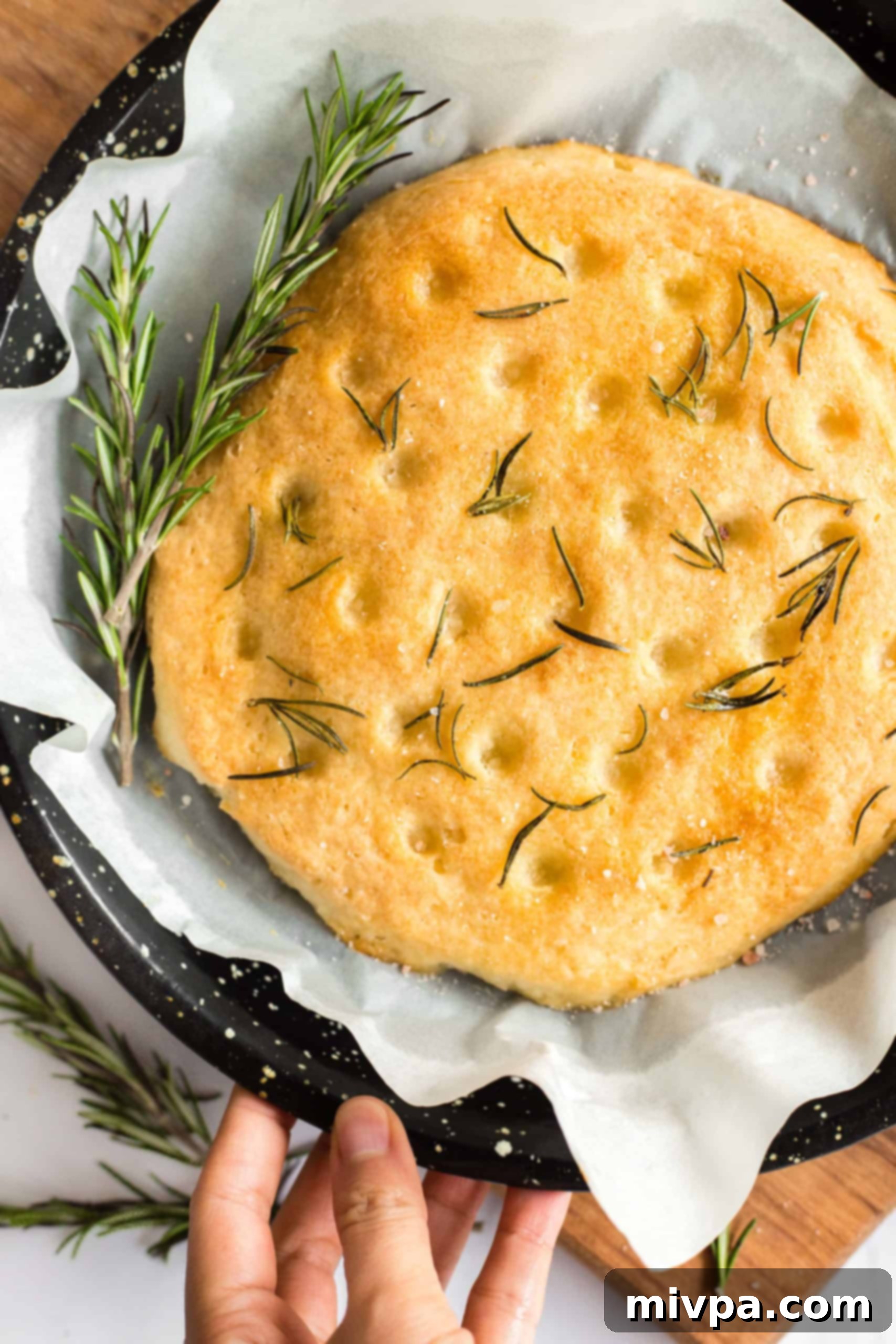
What is Focaccia Bread? A Taste of Italian Tradition
If you’re new to the wonderful world of focaccia bread, or perhaps attempting to bake it for the first time, let’s delve into its origins and defining characteristics. Focaccia is a cherished flat, oven-baked Italian bread, often compared to pizza dough in its general form, yet distinct in its rich texture and versatility. While primarily associated with Ligurian cuisine, focaccia boasts a myriad of regional variations across Italy, sometimes appearing sweet, but most commonly served as a savory delight.
A hallmark of authentic focaccia is the distinctive dimpled surface, created by gently pressing fingers into the dough before baking. These indentations not only add to its rustic charm but also serve a practical purpose, holding puddles of olive oil and seasonings that infuse the bread with incredible flavor. One of the most beloved and widely recognized types of focaccia is rosemary focaccia, or “focaccia al rosmarino” in Italian. This fragrant version is frequently served as an antipasto (starter), a delightful table bread to accompany meals, or a standalone appetizer in traditional Italian dining.
Is Focaccia Gluten-Free? Understanding the Difference
Traditionally, focaccia is crafted using wheat flour, which contains gluten – the protein responsible for the elasticity and structure in many conventional breads. Therefore, standard focaccia is not suitable for individuals with celiac disease or gluten sensitivity. However, this doesn’t mean you have to miss out on this delightful Italian staple! I’ve dedicated time and effort to develop this fantastic gluten-free focaccia recipe, ensuring that everyone can savor its unique taste and texture without any concerns about gluten. This recipe offers all the deliciousness of traditional focaccia, reimagined for a gluten-free lifestyle.
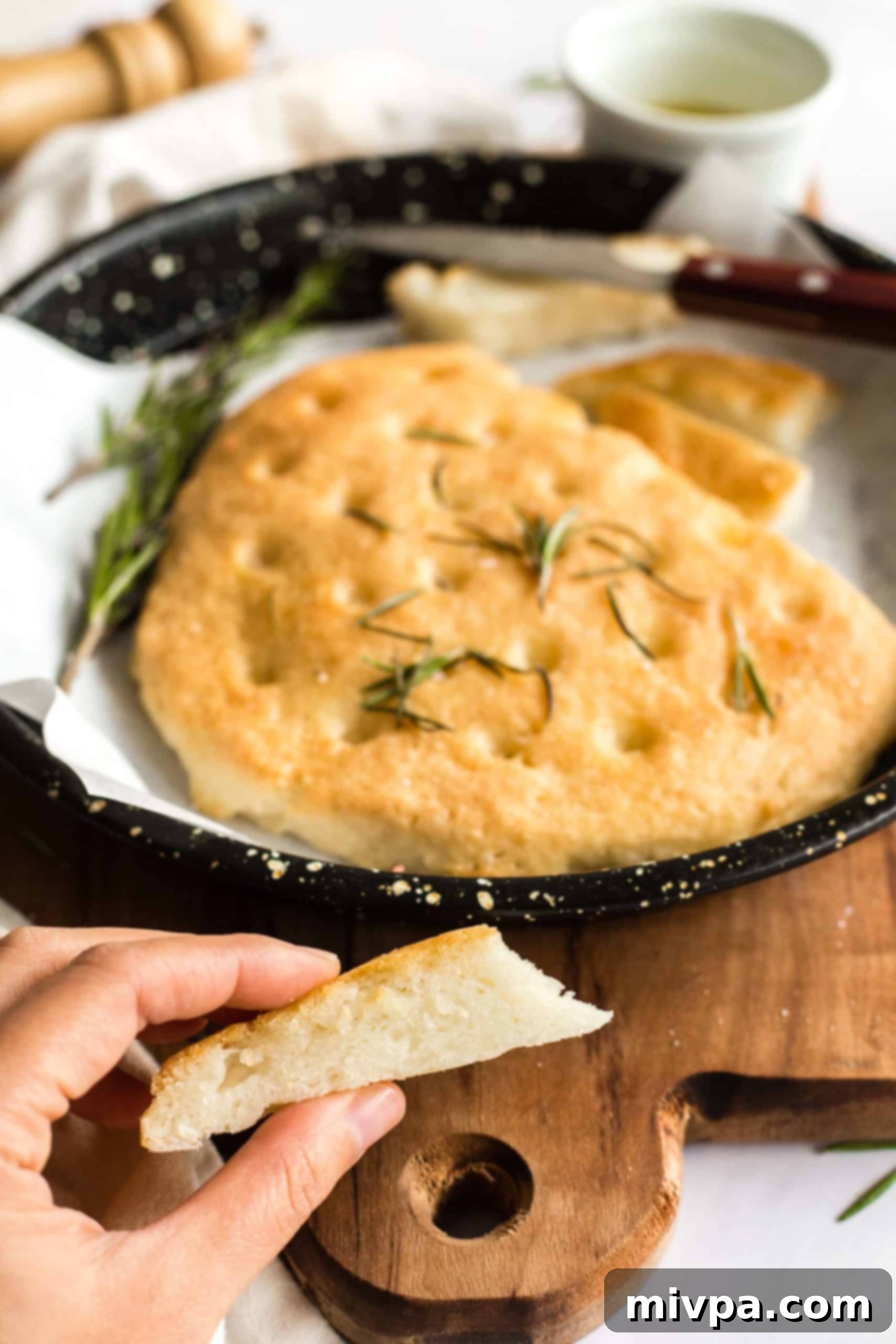
Why This Gluten-Free Focaccia Recipe is a Must-Try
There are many reasons why this easy gluten-free focaccia recipe will become a new favorite in your kitchen. It’s designed to deliver maximum flavor and an authentic focaccia experience, all while being incredibly accessible for various dietary needs:
- Simple, Accessible Ingredients: You won’t need to hunt for exotic items for this recipe. The ingredients required for this gluten-free focaccia bread are readily available at most local grocery stores. In fact, you likely already have many of them on hand in your pantry and fridge. We’ve kept it straightforward – no fancy or hard-to-find components needed!
- Perfect Texture: Soft, Fluffy, Tender, and Crispy: While focaccia is indeed a flatbread, the magic of yeast is crucial for creating its signature fluffy, airy interior – much like a good pizza crust. This particular recipe masterfully strikes the ideal balance: it boasts an irresistibly crusty, golden-brown exterior that gives way to an interior that is amazingly soft, tender, and light. It’s truly a delight to bite into!
- Effortless to Make & No Kneading Required: Say goodbye to strenuous kneading! Unlike traditional wheat bread, gluten-free dough, by its very nature, doesn’t contain the gluten network that requires extensive kneading to develop. This means the process is significantly simpler and quicker. Just like my popular easy gluten-free no-knead bread, this focaccia allows you to achieve impressive results with minimal effort.
- Dietary Inclusive: Gluten-Free, Dairy-Free, and Vegan: This homemade focaccia is designed for everyone to enjoy. It is entirely gluten-free, dairy-free, and vegan, making it an ideal choice for those with celiac disease, gluten intolerance, lactose intolerance, dairy allergies, or following a plant-based diet. You can serve this delicious bread with confidence, knowing it accommodates a wide range of dietary preferences without compromising on taste or quality.
Keep this easy recipe close at hand, because I have a feeling you’ll be making it again and again! Are you ready to dive in and create your own perfect gluten-free focaccia? Let’s get started!
Essential Ingredients for Your Gluten-Free Focaccia
Here’s a helpful visual overview of the key ingredients you’ll need to gather to create this delightful gluten-free focaccia recipe. These components work in harmony to deliver that perfect crispy-on-the-outside, fluffy-on-the-inside texture and incredible flavor.
(For precise quantities and measurements, please refer to the detailed recipe card conveniently located at the bottom of this post.)
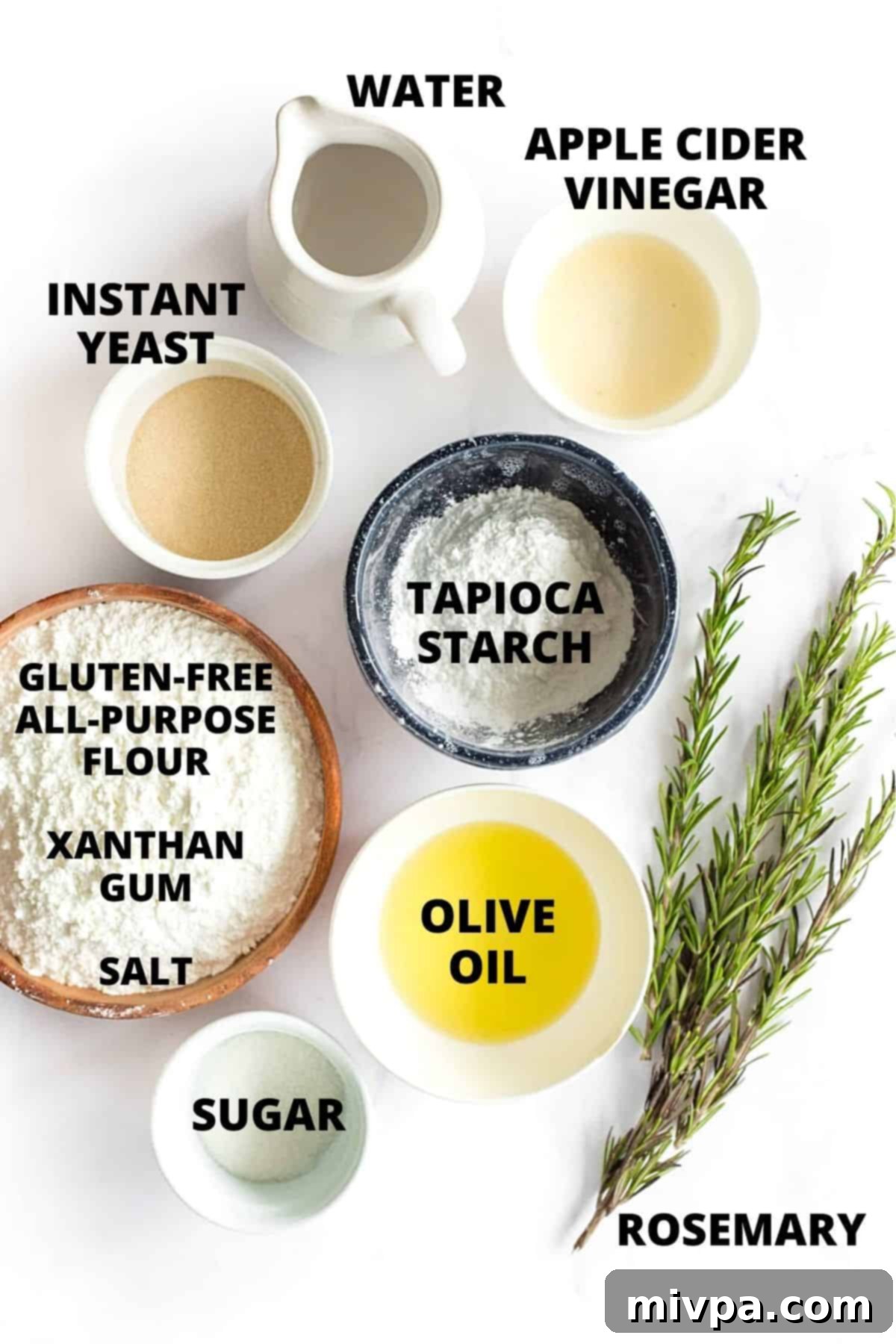
Ingredient Notes and Helpful Substitutions
Understanding the role of each ingredient can greatly enhance your baking success. Here are some important notes and potential substitutions for this gluten-free focaccia recipe:
- Sugar: This isn’t for sweetness! The small amount of sugar acts as “food” for the yeast, helping to activate it and encourage a good rise. It is crucial for the recipe and cannot be omitted. If you prefer not to use granulated sugar, you can substitute it with an equal amount of coconut sugar, or use half the amount if opting for liquid sweeteners like maple syrup or honey. Rest assured, the bread will not taste sweet after baking; the yeast consumes the sugar, and the added salt balances any residual sweetness.
- Instant Yeast: I highly recommend using instant yeast because it is quick-acting and doesn’t require proofing beforehand (though we still activate it with warm water for reassurance). Active dry yeast can also be used, but may require a slightly longer activation time.
- Olive Oil: The quality of your olive oil significantly impacts the flavor and crust of your focaccia. I strongly advocate for using a good quality extra virgin olive oil. It imparts a beautiful, rich flavor and contributes to that desirable golden-brown, crispy crust. If extra virgin olive oil is not available, or you prefer a milder taste, alternatives such as sunflower oil or avocado oil can be used.
- Apple Cider Vinegar: Don’t skip this! Adding apple cider vinegar creates a slightly acidic environment in the dough. This acidity not only helps to tenderize gluten-free flours but also gives the yeast an extra boost, leading to an even better rise and a lighter, fluffier texture.
- Gluten-Free All-Purpose Flour: The type of gluten-free flour blend you choose is critical for the success of this focaccia. I recommend using a high-quality gluten-free all-purpose flour blend that incorporates lighter flours and starches. Look for blends containing ingredients like rice flour (white or brown), corn starch, tapioca starch, or potato starch. These lighter components contribute to a more delicate, airy, and fluffy texture. Conversely, I advise against flour blends that primarily use heavier, denser flours such as garbanzo bean flour (chickpea flour), as these can result in a focaccia with a much denser, harder, and sometimes gritty texture.
- Xanthan Gum: Xanthan gum is an essential ingredient in most gluten-free baking, acting as a substitute for gluten. It helps to bind the ingredients together, providing structure, elasticity, and preventing the bread from crumbling. If your chosen gluten-free flour blend already lists xanthan gum as an ingredient, you can omit the additional amount specified in the recipe. However, if it’s not included, adding it as directed is crucial for achieving the best results.
- Tapioca Starch: Also known as tapioca flour, tapioca starch contributes to the focaccia’s chewy texture and helps create that desirable crispy crust. If you don’t have tapioca starch on hand, you can easily substitute it with an equal amount of arrowroot starch or corn starch (corn flour in some regions).
- Rosemary: Fresh rosemary leaves are used in this recipe as a classic topping, offering a fragrant aroma and beautiful color. While highly recommended for that authentic rosemary focaccia flavor, feel free to get creative with other fresh herbs like oregano or thyme. You can also incorporate other delicious toppings such as thinly sliced garlic, pitted olives (kalamata or green), or even sun-dried tomatoes. The possibilities are endless, allowing you to customize your focaccia to your personal taste.
How to Make Gluten-Free Focaccia Bread (Step by Step Guide)
Baking this gluten-free focaccia is a straightforward process. Follow these detailed steps to achieve perfect results every time:
1. Activate the Yeast
In a medium-sized bowl, combine the instant yeast, sugar, and warm water. Make sure the water temperature is between 105°F and 115°F (40°C-46°C) – too cold and the yeast won’t activate, too hot and it will kill the yeast. Mix these ingredients gently and then set the bowl aside for about 5 minutes. The mixture should become foamy and bubbly, indicating that the yeast is active and alive. If, after 5 minutes, the mixture doesn’t foam, it means your yeast has expired and is no longer viable. In this case, discard the mixture and start again with a fresh packet of yeast. Remember, the sugar is essential here; it provides food for the yeast and won’t make your savory focaccia sweet.
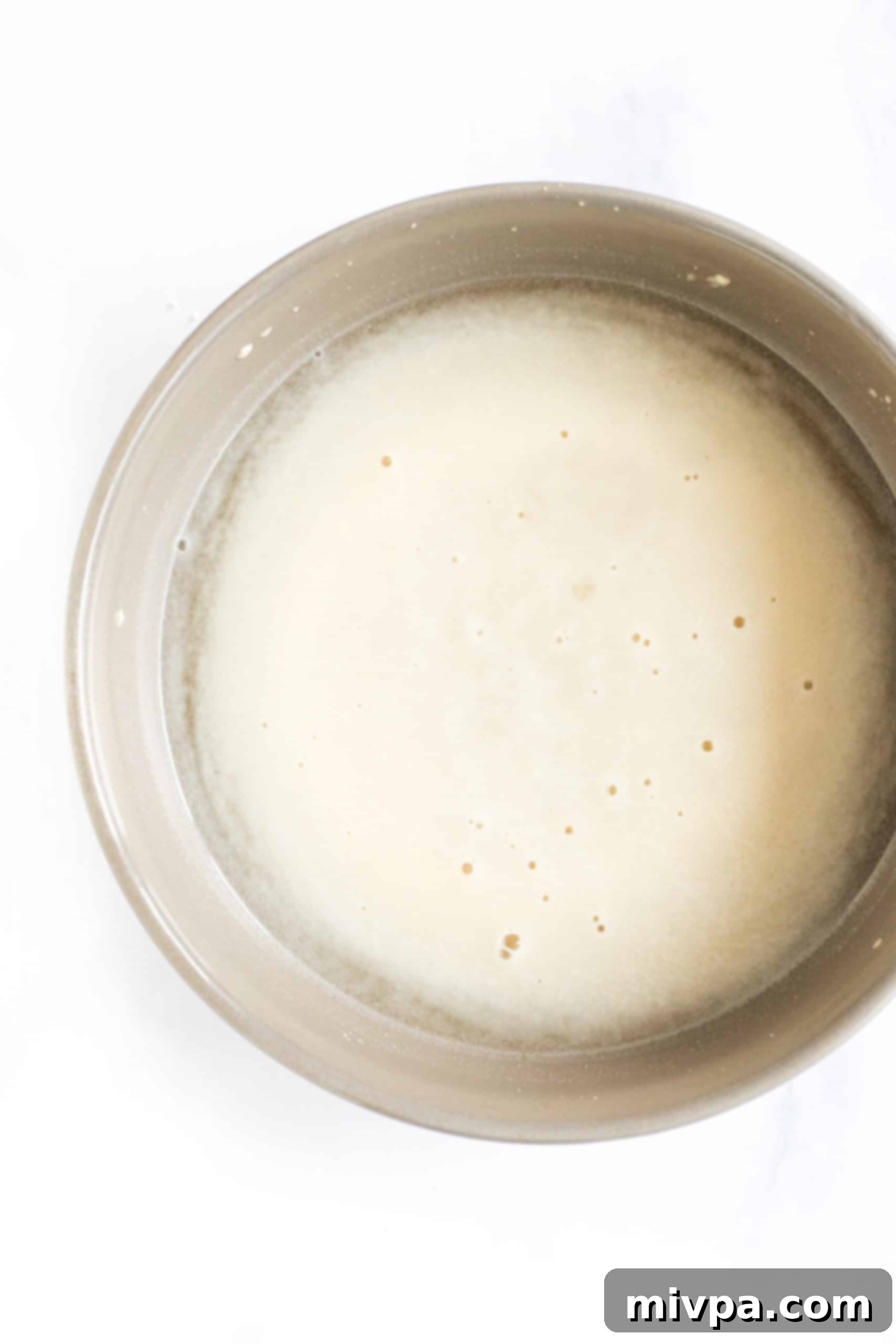
2. Combine Liquid Ingredients with Yeast Mixture
Once your yeast mixture is beautifully foamy, signaling its activity, transfer it to a large mixing bowl. Add 1/4 cup of the extra virgin olive oil and the apple cider vinegar to the bowl. Whisk everything together thoroughly until all the liquid ingredients are well combined. This liquid base will ensure a smooth and even distribution of flavors throughout your focaccia dough.
3. Whisk Dry Ingredients Separately
In a separate large bowl, combine all the dry ingredients: the gluten-free all-purpose flour blend, xanthan gum (if your flour blend doesn’t already contain it), tapioca starch, and sea salt. Use a whisk to thoroughly combine these ingredients. This step is crucial to ensure that the xanthan gum and leavening agents are evenly distributed throughout the flour, preventing pockets of unmixed ingredients and promoting a consistent texture in the final bread.
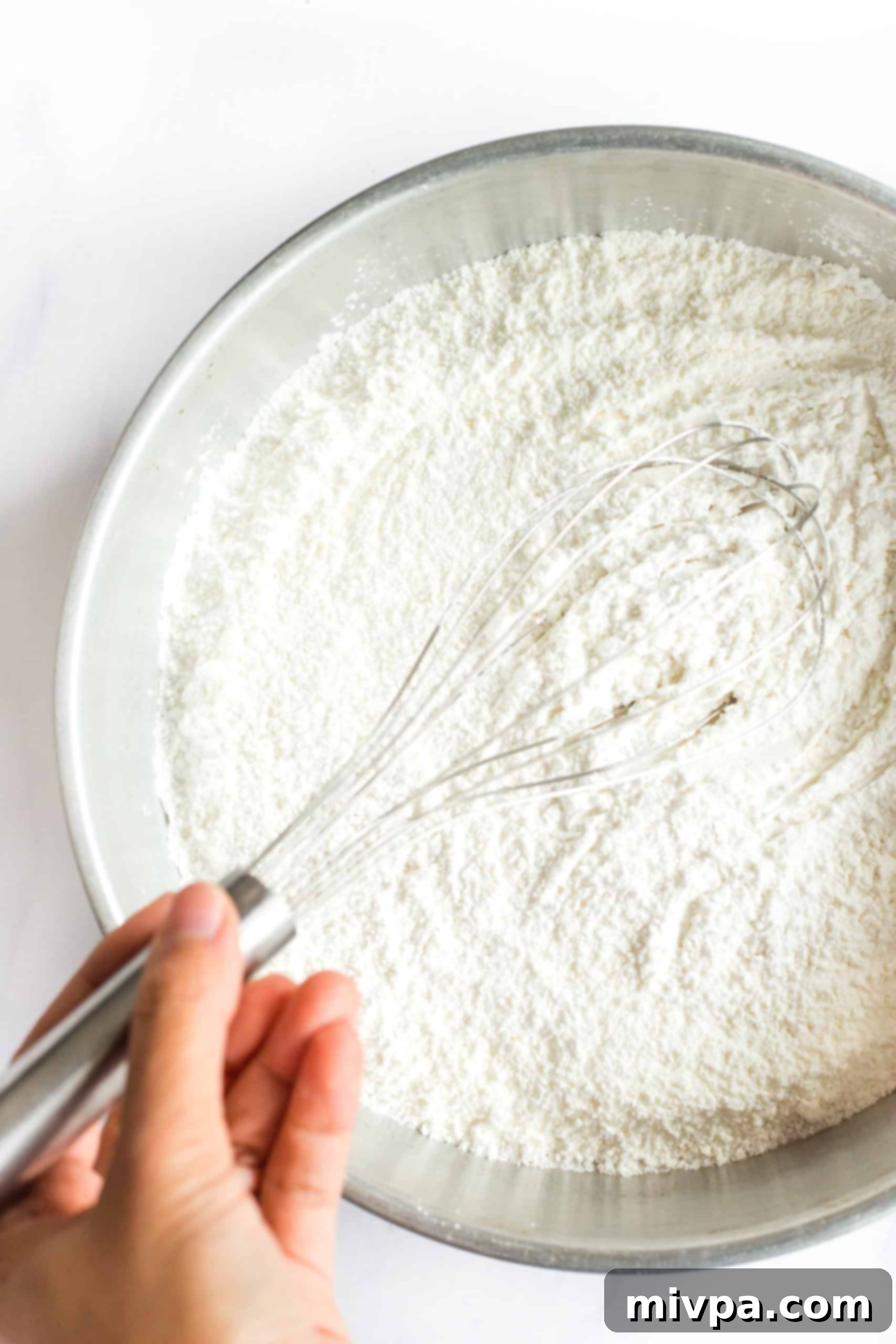
4. Combine Wet and Dry to Form Dough
Now, gradually add the whisked dry ingredients to the bowl containing the wet ingredients and the activated yeast. Mix everything together well, either with a sturdy spoon or a stand mixer with a paddle attachment, until you achieve a homogeneous and sticky dough. It’s absolutely normal for gluten-free bread dough to be noticeably wetter and stickier than traditional wheat dough due to the absence of gluten. Resist the urge to add more flour, as this will lead to a dense, hard, and dry focaccia. Embrace the stickiness – it’s a sign of a perfectly hydrated gluten-free dough!
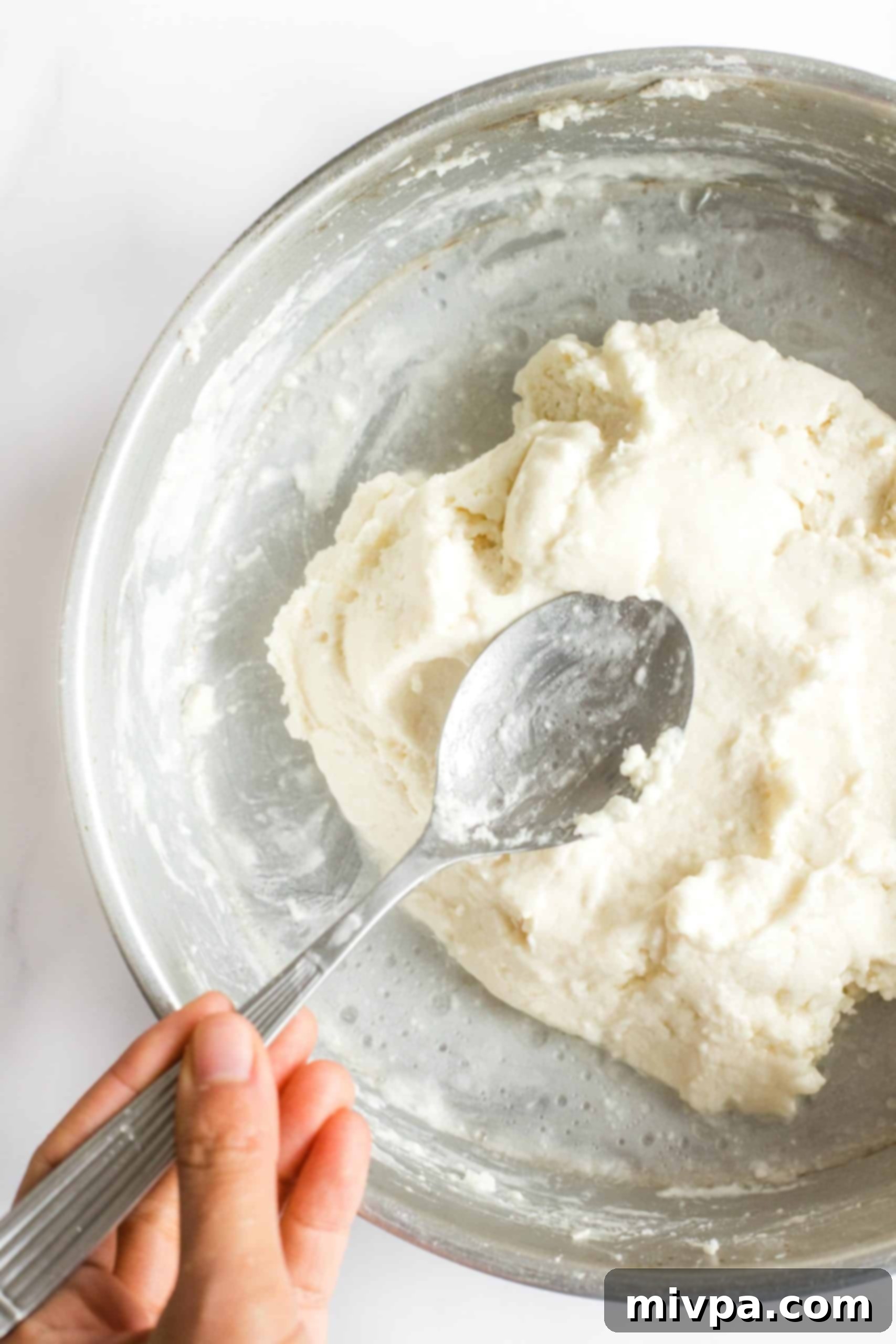
5. Transfer Dough to Prepared Pan
Prepare your baking pan by lining it with parchment paper. This crucial step prevents sticking and makes for easy removal later. Lightly grease the parchment paper with a little bit of oil. Carefully transfer the sticky focaccia dough onto the prepared baking sheet. Using wet fingers (this prevents sticking to your hands), gently spread the dough out into a round disc, aiming for a thickness of about 1.5 inches. Ensure an even thickness for uniform baking.
6. Allow the Dough to Rise
Once the dough is shaped in the pan, place it in a warm, draft-free spot. Let it rise for approximately 45 minutes. While gluten-free doughs don’t typically double in size like their gluten-containing counterparts, you will notice a significant increase in volume, and the dough will appear noticeably fluffier than before rising. This rise is essential for developing a light and airy internal structure.
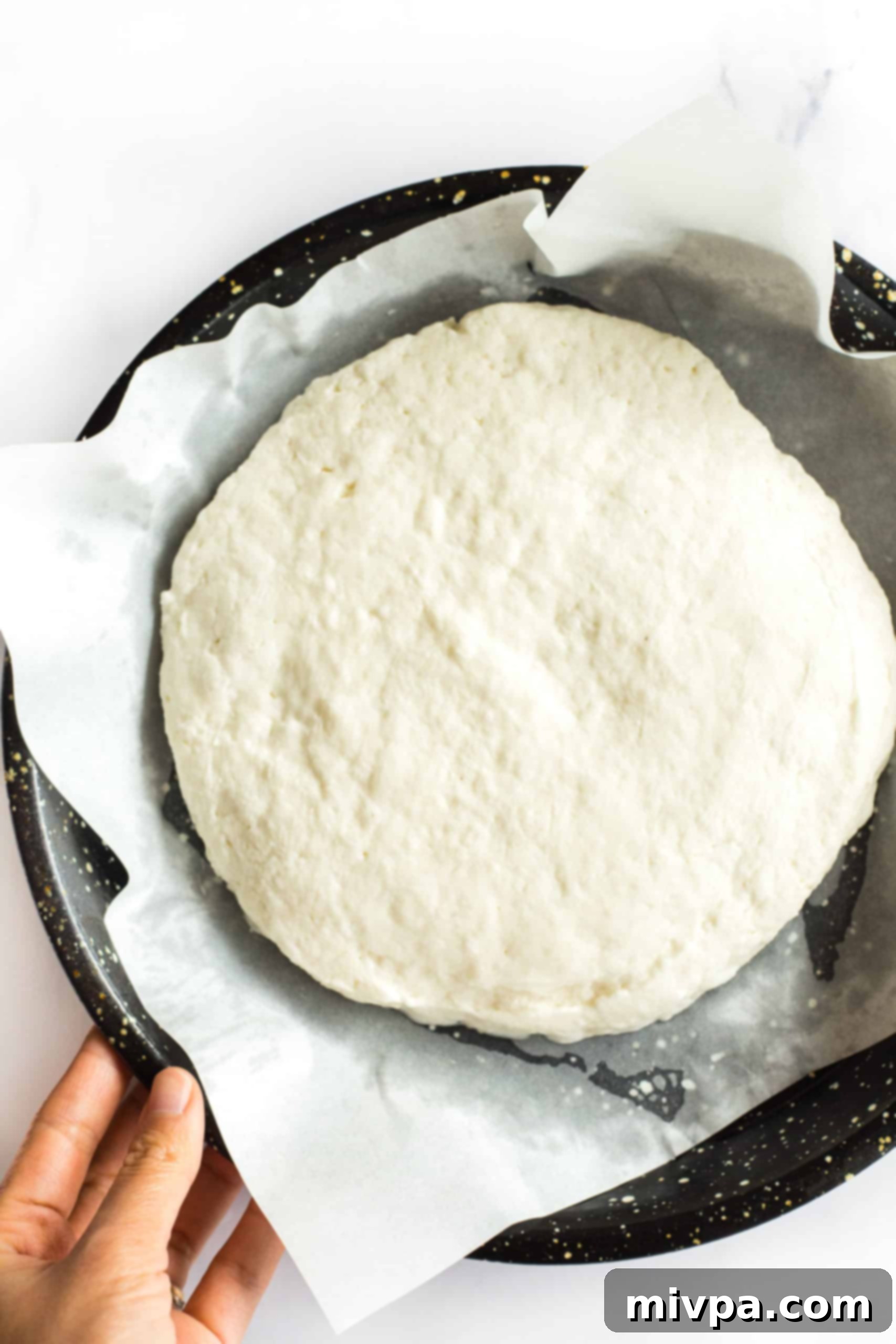
7. Preheat Your Oven
During the last 10 minutes of the dough’s rising time, preheat your oven to 400°F (200°C). Ensuring the oven is fully preheated before the focaccia goes in is vital for a good initial rise and even baking, contributing to that desirable crispy crust.
8. Create Characteristic Dimples
After the gluten-free focaccia dough has completed its rise, dip your pinky finger into a small bowl of water. Use your wet finger to gently poke evenly-spaced dimples across the entire surface of the bread dough. These “craters” are not just for aesthetics; they are a defining characteristic of traditional Italian focaccia bread, allowing the olive oil and seasonings to pool and infuse deeply into the bread, enhancing both flavor and texture.

9. Brush with Oil and Season Generously
Take the remaining 2 tablespoons of olive oil and generously brush it over the entire surface of the dimpled dough. Make sure every part of the surface is coated; this olive oil bath is key to achieving that wonderfully crusty, golden-brown exterior once baked. Immediately after brushing, sprinkle the surface liberally with fresh rosemary leaves and a good pinch of sea salt. This final seasoning adds depth of flavor and a beautiful aromatic finish.

10. Bake to Golden Perfection
Carefully transfer the prepared focaccia dough to the middle rack of your preheated oven. Bake for approximately 45 to 55 minutes. The baking time may vary slightly depending on your oven, so keep an eye on it. The focaccia is ready when its top has turned a beautiful golden-brown color and the crust feels firm and crispy to the touch.
11. Cool Before Slicing and Serving
Once baked, remove the gluten-free rosemary focaccia from the oven. Resist the temptation to slice into it immediately! Allow it to cool slightly at room temperature on a wire rack. Cooling allows the internal structure to set properly and prevents the bread from becoming gummy. After a brief cooling period, slice and serve your warm, homemade focaccia. Enjoy the incredible aroma and taste!
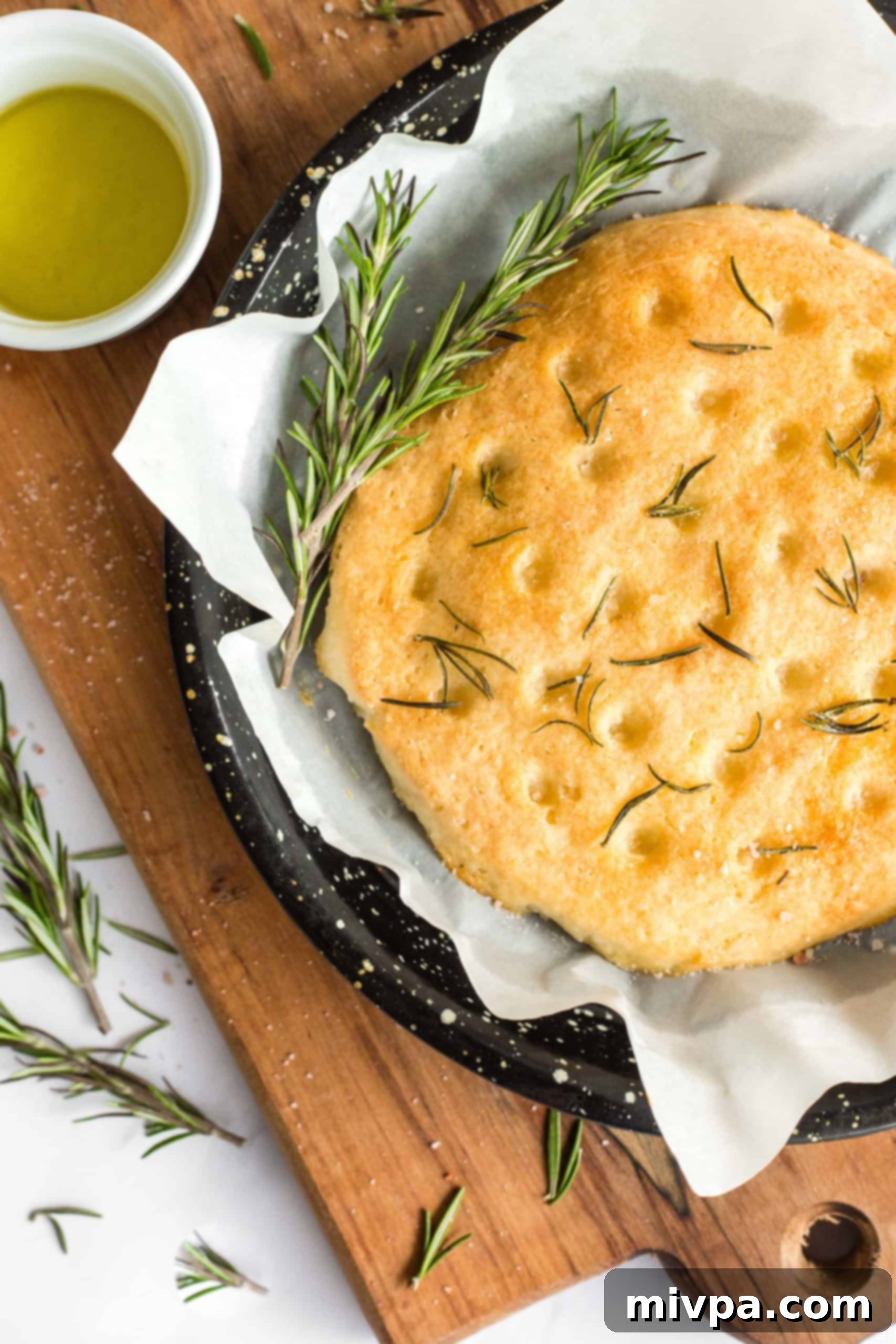
Dish by Dish Tips & Tricks for the Best Focaccia
Elevate your gluten-free focaccia game with these additional tips and tricks:
- Herb Variations: While fresh rosemary is a classic choice, feel free to experiment with other fresh herbs that you love. Thyme, oregano, or a mix of Italian herbs can be wonderful alternatives. If you’re using dried herbs instead of fresh, remember that dried herbs are far more concentrated in flavor. A good rule of thumb is to use about 1/3 the amount of dried herbs compared to fresh. For example, if the recipe calls for 1 tablespoon of fresh rosemary, use about 1 teaspoon of dried rosemary.
- Additional Toppings for Customization: Unleash your creativity with additional toppings! For an extra burst of flavor and visual appeal, consider pressing pitted olives (such as Kalamata or green olives) or halved cherry tomatoes into the dough before baking. If you enjoy a touch of heat, sprinkle the focaccia with flaky sea salt, freshly ground black pepper, or a dash of red pepper flakes over the olive oil and rosemary.
- Always Line with Parchment Paper: This tip cannot be stressed enough! Always line your baking sheet with parchment paper. Gluten-free dough can be prone to sticking, and parchment paper ensures that your beautifully baked focaccia can be easily removed from the pan without leaving its crispy bottom crust behind. Lightly oiling the parchment paper is an extra layer of protection.
Frequently Asked Questions About Gluten-Free Focaccia
To maintain its freshness, allow the gluten-free rosemary focaccia to cool completely at room temperature. Once cooled, place it in an airtight container or wrap it tightly in plastic wrap. Store it in the refrigerator, where it will remain delicious for up to one week. For best texture, lightly toast or warm it in the oven before serving.
Absolutely! This focaccia bread freezes wonderfully. After baking, ensure the focaccia has cooled entirely. Place it in a freezer-safe container or a heavy-duty ziplock bag, removing as much air as possible to prevent freezer burn. It can be frozen for up to 3 months. When you’re ready to enjoy it, simply transfer the frozen focaccia to the refrigerator and let it thaw completely overnight. Once thawed, you can toast slices or warm the whole focaccia in the oven at 350°F (175°C) for about 10-15 minutes, or until heated through and crisp.
Serving Suggestions: What to Eat with Your Rosemary Focaccia Bread
The hard work of baking and the waiting during the rise and bake times are finally over – it’s time to indulge! I know the irresistible aroma of freshly baked gluten-free focaccia is calling your name. But what are the best ways to enjoy this gorgeous bread? Its versatility means there are countless delicious pairings, but here are some of my favorite ways to serve this Italian rosemary focaccia:
- Dipped in Olive Oil: The simplest and often most satisfying way to enjoy focaccia is by dipping warm slices into high-quality extra virgin olive oil. The oil soaks into the fluffy interior, creating a heavenly bite. Add a pinch of flaky sea salt and freshly ground black pepper to the oil for an extra layer of flavor.
- Accompaniment to Hearty Soups: Focaccia is the perfect companion to a warm bowl of soup. Its robust flavor and satisfying texture make it ideal for soaking up every last drop. Try it with a vibrant Carrot Turmeric Soup (Gluten-Free) or a comforting Pumpkin Soup (Gluten-Free, Vegan).
- With Delicious Dips: Elevate your appetizer spread by serving focaccia alongside flavorful dips. It pairs exceptionally well with our creamy Easy Creamy Hummus (Gluten-Free, Vegan), the smoky Grilled Eggplant Sesame Dip (Gluten-Free, Paleo), or a vibrant Roasted Red Pepper Dip (Gluten-Free, Vegan).
- As a Side for Main Courses: Serve it alongside your favorite Italian meals, grilled chicken, fish, or a fresh salad. It adds a wonderful textural element and a burst of herbaceous flavor to any plate.
- Mini Sandwiches or Bruschetta: Slice the focaccia horizontally to make mini sandwiches with your favorite fillings, or toast small pieces and top them with bruschetta toppings like fresh tomatoes and basil.
However you choose to enjoy it, this rosemary focaccia bread is guaranteed to be a crowd-pleaser and a versatile addition to your gluten-free repertoire!
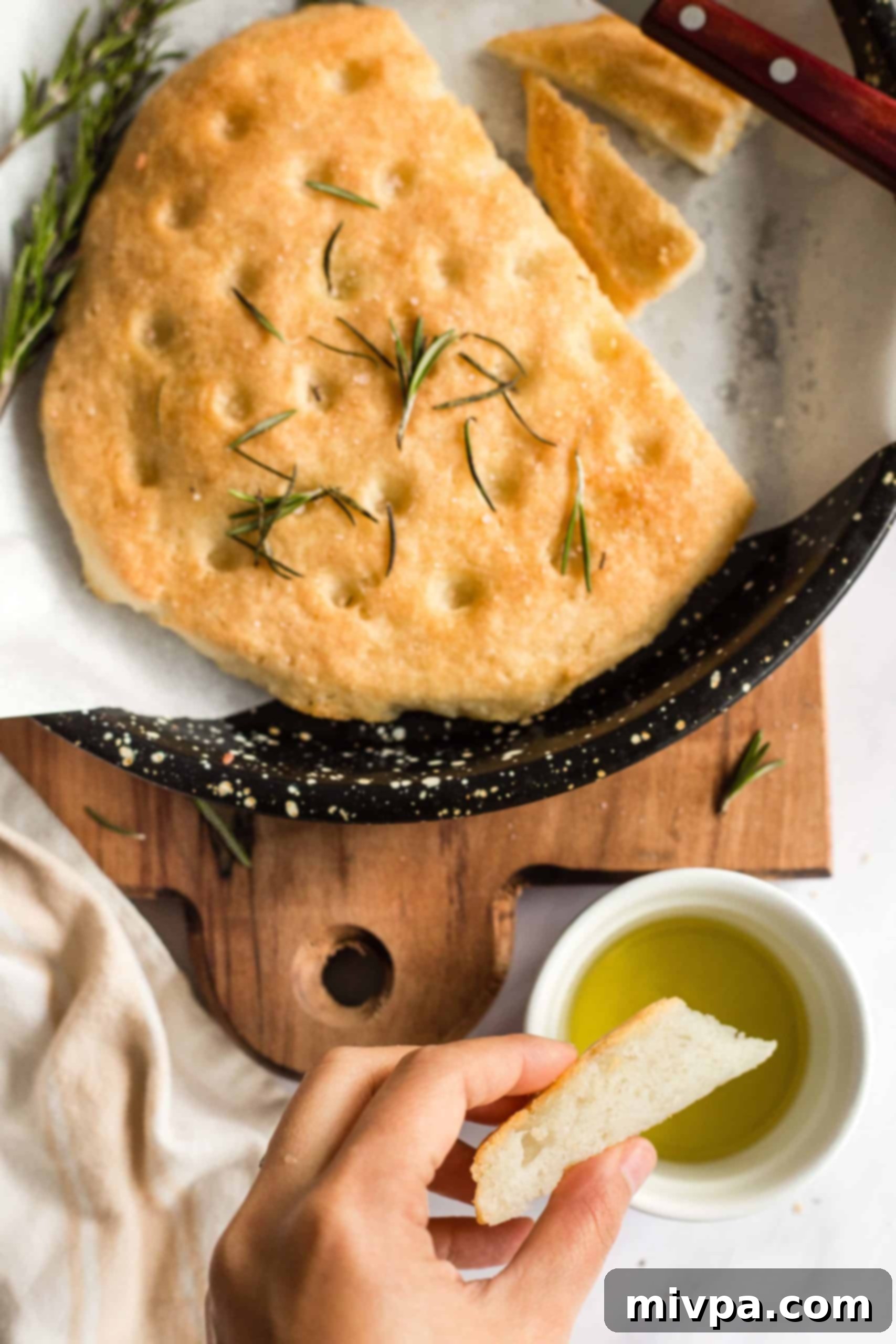
More Gluten-Free Bread Recipes You’ll Adore!
If you loved making this focaccia, you’ll be thrilled to discover other delicious gluten-free bread recipes from my kitchen:
- Easy Gluten-Free Naan Bread (Dairy-Free)
- Easy Gluten-Free No-Knead Bread (Dairy-Free)
- Easy Gluten-Free Sandwich Bread (Vegan)
- Gluten-Free Honey Oat Quick Bread
- Gluten-Free Skillet Cornbread
- 10 Easy Gluten-Free Bread Recipes to Make on Repeat
Delicious Appetizers to Pair With Your Focaccia
Beyond dipping, focaccia is a fantastic foundation for a variety of appetizers. Here are some of our top picks that would beautifully complement a slice of your homemade gluten-free focaccia:
- Easy Chicken Satay with Peanut Sauce (Gluten-Free, Dairy-Free)
- Crispy Cornflake Chicken Strips (Gluten-Free, Dairy-Free)
- Caprese Pesto Pasta Salad (Gluten-Free)
- Crunchy Cabbage Salad with Peanut Dressing (Gluten-Free, Vegan)
P.S. If you try this recipe, I’d love for you to leave a star rating below, and/or a review in the comment section further down the page. I always appreciate your feedback. Be sure to check out my entire Recipe Index for all the recipes on the blog. You can also follow me on Pinterest, Facebook or Instagram! Sign up for my Email List to get fresh recipes in your inbox each week!
Print Recipe

Amazing Gluten-Free Focaccia Bread (Dairy-Free, Vegan)
5 Stars 4 Stars 3 Stars 2 Stars 1 Star
5 from 5 reviews
Author: felicia | Dish by Dish
Total Time: 1 hour 50 minutes
Yield: 8 servings
Diet: Gluten Free, Dairy Free, Vegan
Description
Get ready to bake the most incredible gluten-free focaccia bread at home! This recipe yields a beautifully crispy crust and a wonderfully soft, fluffy interior, making it an absolute delight. Infused with fragrant rosemary, this Italian focaccia is incredibly easy to prepare and tastes truly authentic. It’s the perfect versatile bread, ideal as a side dish for savory meals, an impressive appetizer alongside dips like our easy creamy hummus, or simply enjoyed with a drizzle of your favorite extra virgin olive oil. What’s more, it’s designed to be inclusive, so everyone can enjoy it, being completely gluten-free, dairy-free, and vegan.
Ingredients
Units
Scale
- 1 cup warm water (between 105F to 115F / 40C to 46C)
- 1 tablespoon granulated sugar (for yeast activation)
- 1 1/4 teaspoons instant yeast
- 1/4 cup extra virgin olive oil, plus 2 tablespoons for brushing
- 1 teaspoon apple cider vinegar
- 1 3/4 cups gluten-free all-purpose flour blend (ensure it’s a lighter blend)
- 1/2 teaspoon xanthan gum (omit if your blend already includes it)
- 1/4 cup tapioca starch (or arrowroot starch/corn starch)
- 2 teaspoons sea salt, plus more for sprinkling on top
- 1 tablespoon fresh rosemary leaves, chopped (optional, but highly recommended)
Instructions
- Activate Yeast: In a medium-size bowl, combine the instant yeast, granulated sugar, and warm water (105F-115F / 40C-46C). Stir gently until combined. Set aside for 5-10 minutes until the mixture becomes foamy. If the yeast doesn’t foam after this time, it indicates it is expired; discard and begin again with fresh yeast.
- Prepare Liquid Mixture: Once the yeast mixture is actively foamy, transfer it to a large mixing bowl. Add 1/4 cup of the extra virgin olive oil and the apple cider vinegar. Whisk everything together thoroughly until the liquid ingredients are well incorporated.
- Combine Dry Ingredients: In a separate bowl, whisk together the gluten-free all-purpose flour blend, xanthan gum (if using), tapioca starch, and sea salt. Ensure these dry ingredients are thoroughly mixed to prevent lumps.
- Form the Dough: Gradually add the whisked dry ingredients to the bowl with the wet ingredients. Mix well with a sturdy spoon or a stand mixer with a paddle attachment until a homogeneous and sticky dough forms. Remember, gluten-free dough will be wet and sticky; do not add extra flour, as this will result in a dry focaccia.
- Transfer and Shape: Line a round baking pan (or a 9×13 inch rectangular pan) with parchment paper and lightly grease the parchment. Transfer the sticky dough to the prepared pan. Using wet fingers, gently spread the dough evenly into a 1.5-inch thick disc (or rectangle, if using a rectangular pan).
- First Rise: Place the pan with the dough in a warm, draft-free spot. Allow the dough to rise for approximately 45 minutes. While it may not double in size like traditional dough, it should visibly increase in volume and appear fluffier.
- Preheat Oven: During the final 10 minutes of the dough’s rise time, preheat your oven to 400°F (200°C).
- Create Dimples: Once the dough has risen, dip your pinky finger in water and gently poke evenly-spaced dimples across the entire surface of the focaccia dough. These dimples help hold the olive oil and seasonings.
- Brush and Season: Generously brush the dough with the remaining 2 tablespoons of extra virgin olive oil, ensuring the entire surface is coated for a golden, crispy crust. Immediately sprinkle the surface with fresh rosemary leaves and an extra pinch of sea salt.
- Bake to Perfection: Place the pan on the middle rack of your preheated oven. Bake for 45 to 55 minutes, or until the top is beautifully golden brown and the crust is firm and crispy.
- Cool and Serve: Once baked, remove the focaccia from the oven and allow it to cool slightly at room temperature on a wire rack before slicing and serving warm. Enjoy!
Notes
Sugar: The sugar is vital for activating the yeast and ensuring a good rise; it will not sweeten the final bread. You can substitute with an equal amount of coconut sugar, or half the amount of maple syrup or honey if preferred.
Instant Yeast: I prefer instant yeast for its immediate activation. Ensure your yeast is fresh for optimal results.
Olive Oil: For the best flavor and a beautiful golden crust, I highly recommend extra virgin olive oil. Alternatives include sunflower oil or avocado oil.
Apple Cider Vinegar: This ingredient creates an acidic environment that aids in yeast activity and contributes to a lighter, fluffier texture. Do not omit it.
Gluten-Free All-Purpose Flour: Choose a good-quality gluten-free all-purpose flour blend that contains lighter starches (e.g., rice, corn, tapioca, potato starch) for a superior texture. Avoid blends with heavy flours like garbanzo bean flour, which can lead to a dense bread.
Xanthan Gum: Xanthan gum is essential for providing structure and binding in gluten-free baking. If your chosen flour blend already contains it, you can skip adding extra.
Tapioca Starch: For a chewy texture and crispy crust, tapioca starch is excellent. If unavailable, arrowroot starch or corn starch can be used as a 1:1 substitute.
Rosemary: Fresh rosemary is highly recommended for its aromatic qualities. You can also experiment with other fresh herbs like oregano or thyme, or add toppings such as olives, sun-dried tomatoes, or garlic for varied flavors. If using dried herbs, use 1/3 the amount of fresh.
Serve this With: This gluten-free focaccia is incredibly versatile. Enjoy it simply with extra virgin olive oil for dipping. It’s also a perfect accompaniment to soups like my vegan pumpkin soup or carrot turmeric soup. For appetizers, pair it with our easy creamy hummus or grilled eggplant sesame dip.
Storing/Freezing: Store cooled focaccia in an airtight container in the refrigerator for up to a week. For longer storage, freeze it in a freezer-safe bag for up to 3 months. Thaw overnight in the refrigerator before reheating in the oven or toasting.
This recipe was originally published in June 2020, and has been thoroughly updated in [Current Month, Year] to include enhanced recipe notes, ingredient substitutions, clearer step-by-step instructions, and additional photos for an even better baking experience.
- Prep Time: 55 mins
- Cook Time: 55 mins
- Category: Bread, Appetizer
- Method: Baking
- Cuisine: Italian
